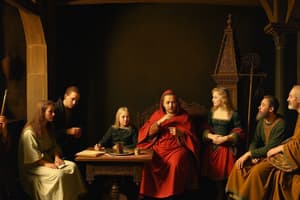Podcast
Questions and Answers
How was society structured in the Middle Ages?
How was society structured in the Middle Ages?
Medieval society was feudal, based on a rigid hierarchy and divided into three orders: the nobles, the clergy, and the peasants.
What does it mean that Medieval society was rigid?
What does it mean that Medieval society was rigid?
People believed these three orders were established by God, and there was no way to change this system.
Who were the nobles?
Who were the nobles?
The nobles were at the top of the social hierarchy, had titles, wealth, and fought in wars.
What does it mean that the titles were hereditary?
What does it mean that the titles were hereditary?
What was the purpose of the right of primogeniture?
What was the purpose of the right of primogeniture?
Who was a vassal?
Who was a vassal?
Who were the clergy?
Who were the clergy?
Why did members of the clergy often overlap with the first order (the nobility)?
Why did members of the clergy often overlap with the first order (the nobility)?
What type of life did the clergy have?
What type of life did the clergy have?
Who were the peasants?
Who were the peasants?
How did the peasants live?
How did the peasants live?
When did things start to change in Medieval society?
When did things start to change in Medieval society?
Why did the social structure change after the plague?
Why did the social structure change after the plague?
What happened to the nobility after the changes in society?
What happened to the nobility after the changes in society?
Study Notes
Structure of Medieval Society
- Medieval society was organized into a feudal system with a strict hierarchy divided into three main orders: nobles, clergy, and peasants.
- Social classes were believed to be divinely established, resulting in a rigid and unchangeable structure.
Nobility
- Nobles occupied the highest position in the social hierarchy, holding titles and wealth, and were responsible for military service in wars.
- Titles included king, duke, earl, and knight, with knights being the lowest rank among the nobility.
- Titles and property were hereditary, typically passed from father to the eldest son, reinforcing family wealth through the right of primogeniture.
Right of Primogeniture
- The right of primogeniture ensured only the first male heir inherited titles and properties, preserving family wealth across generations.
Vassals
- Vassals were individuals who pledged loyalty to a lord in exchange for protection, agreeing to fight in support of their lord.
Clergy
- The clergy ranked just below nobles and were officially recognized members of the Church dedicated to spiritual pursuits.
- Many clergy members hailed from noble families due to right of primogeniture, leading younger sons to pursue religious roles instead of inheriting titles.
Lifestyle of the Clergy
- Clergy members were required to take vows of chastity and poverty but often retained considerable property and wealth, maintaining privileges tied to their noble backgrounds.
- Despite their religious duties, their lifestyles displayed significant material wealth, leading to a paradox of power over spirituality.
Peasantry
- Peasants constituted the majority, comprising 90-95% of the population, while nobles and clergy only represented a minority.
- Peasants were landless individuals who worked on lord's estates, living under the lord’s protection in exchange for their labor.
Life of Peasants
- Peasants, or serfs, were bound to a lord's estate for life, requiring permission from the lord for personal matters such as marriage, highlighting their lack of autonomy.
Changes in the 14th Century
- The Black Death, a catastrophic plague in the 14th century, drastically reduced Europe's population by nearly half, destabilizing the established social structure.
- This period marked the beginning of social mobility, with peasants seeking better opportunities.
Economic Shifts
- As towns developed into economic and trade centers, many peasants migrated from rural areas, becoming merchants or tradespeople, leading to wealth accumulation outside the feudal structure.
Nobility's Challenges
- Nobles faced financial challenges, often being titled yet cash-poor, prompting strategic marriages into the lower classes to secure financial stability.
- This shift marked the emergence of a new middle class, disrupting traditional social hierarchies.
Studying That Suits You
Use AI to generate personalized quizzes and flashcards to suit your learning preferences.
Description
Explore the rigid structure of Medieval society through these flashcards. Learn about the three distinct social classes: nobles, clergy, and peasants, and understand how this hierarchy was viewed as divinely ordained. Test your knowledge of the social order that defined the Middle Ages.



